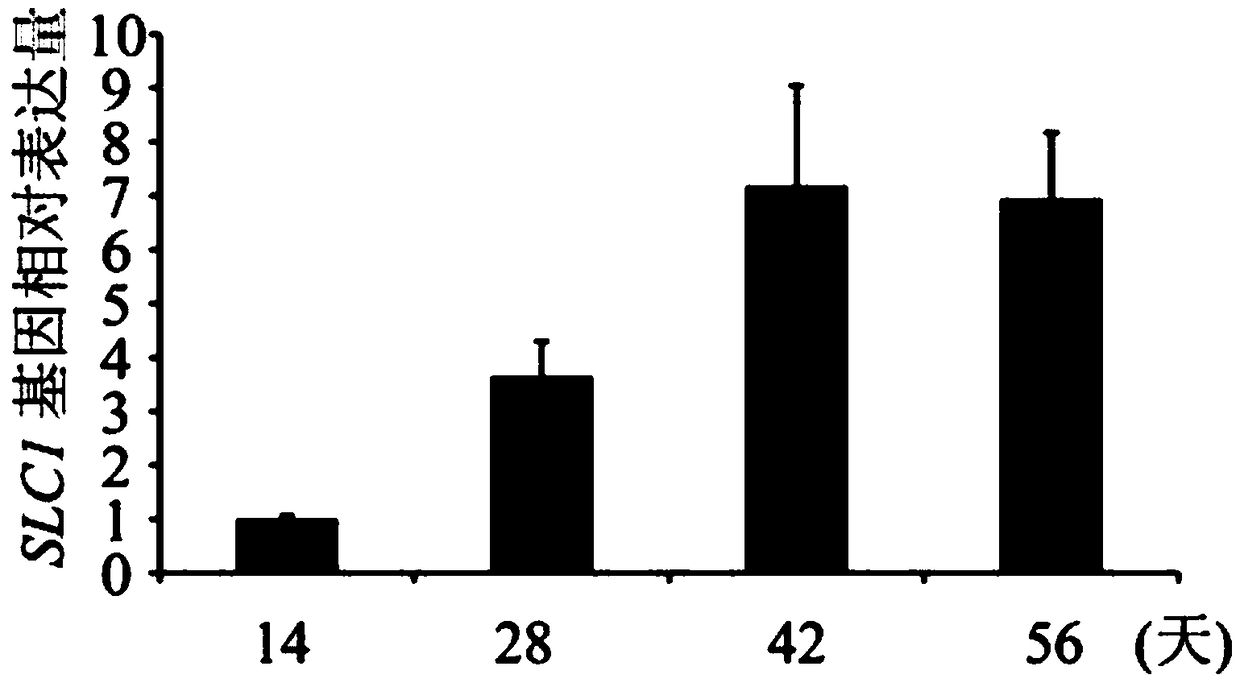Black and ageing specific inducing promoter, engineering vector and application
A promoter and dark technology, applied in the field of genetic engineering, can solve problems such as premature leaf senescence and shedding, abiotic stress, such as pests and diseases, long-term low light/darkness, drought, abnormal temperature, affecting crop yield and quality, etc., to achieve inhibition effects of aging
- Summary
- Abstract
- Description
- Claims
- Application Information
AI Technical Summary
Problems solved by technology
Method used
Image
Examples
Embodiment 1
[0038] A dark and aging-specific inducible promoter, the promoter is shown in the nucleotide sequence of SEQ ID NO:1.
[0039]The promoter contains a 5'UTR sequence, which is located at position 333-461 of the sequence. In subsequent promoter applications, in order to ensure the driving effect of the SLC1 promoter, this 5'UTR sequence is included in the construction of the engineering vector
[0040] The promoter has eukaryotic promoter core elements TATA-box and CAAT-box, which are respectively located at positions 300-303 and positions 326-329 of the sequence.
[0041] The preparation process of the promoter is as follows: extract wild-type Arabidopsis col genomic DNA, and use SLC1 promoter-specific primers (proSLC1F:GAATTTAATCAAACACCTTCT; proSLC1R:CACGCTAGTACCCAAAAC) for PCR amplification; amplification procedure: step1: 95°C for 3 minutes; step2: 95 30s at ℃, 30s at 57℃, 30s at 72℃, 32 cycles; step3: 10min at 72℃. After the reaction, the PCR fragment was recovered and co...
Embodiment 2
[0043] qRT-PCR identification of SLC1 promoter induced by darkness and senescence:
[0044] In order to clarify the expression characteristics of the SLC1 promoter, the applicant used qRT-PCR technology to detect the expression of the SLC1 gene at the transcriptional level. In the experiment, the sixth rosette leaf of the wild-type Arabidopsis col grown for 28 days was darkened for 12 hours For treatment, the materials were taken at 0, 3, 6, and 12 hours respectively, and RNA was extracted, reverse-transcribed into cDNA, and used as a template, using primers: SLC1-qRTF:CACTCAAAGTGTGTGGAGGA, SLC1-qRTR:CTGTCGCCGGCGTTAATGGAG for qRT-PCR analysis; The results show that if figure 1 As shown, the transcription level of SLC1 gene can be induced by darkness, indicating that the SLC1 promoter has the characteristic of being induced by darkness; in addition, we detected the change of transcription level of SLC1 with the process of leaf senescence, and extracted and grown 14 days, 28 day...
Embodiment 3
[0046] Histochemical staining (GUS staining) and luciferase method (LUC) identified that the SLC1 promoter can be induced by darkness and aging:
[0047] (1) Histochemical staining (GUS): Design specific primers (proSLC1-GUSF: GCAGGCATGCAAGCTTGAATTTAATCAAACACCTTCT; proSLC1-GUSR: CTCAGATCTACCATGGCACGCTAGTACCCCAAAACA) for cloning the SLC1 promoter with linkers, and extract wild-type col Arabidopsis genomic DNA as The template was amplified, the amplification program: step1: 95°C for 3min; step2: 95°C for 30s, 56°C for 30s, 72°C for 30s, 32 cycles; step3: 72°C for 10min.
[0048] After the amplified product was recovered and purified, it was ligated into the pCAMBIA3301-GUS vector using infusion recombination technology. The method and system were: 2 μL of SLC1 promoter fragment, 2 μL of pCAMBIA3301-GUS (after double digestion with HindIII and NcoI), 1 μL of infusion enzyme; 50°C After reacting for 15 minutes, the ligation product was transformed into Escherichia coli DH5a, and t...
PUM
 Login to View More
Login to View More Abstract
Description
Claims
Application Information
 Login to View More
Login to View More - Generate Ideas
- Intellectual Property
- Life Sciences
- Materials
- Tech Scout
- Unparalleled Data Quality
- Higher Quality Content
- 60% Fewer Hallucinations
Browse by: Latest US Patents, China's latest patents, Technical Efficacy Thesaurus, Application Domain, Technology Topic, Popular Technical Reports.
© 2025 PatSnap. All rights reserved.Legal|Privacy policy|Modern Slavery Act Transparency Statement|Sitemap|About US| Contact US: help@patsnap.com



